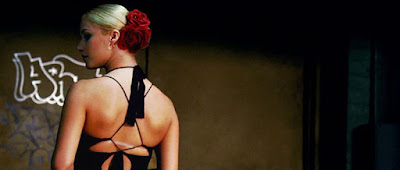My history with dancing is quickly thus: I went to a '50s "swing" party back in the day and had three cute girls tell me they could teach me how to dance. Two minutes later they all said, "Luke, go practice... by yourself... over there." Then, in the musical "Hello, Dolly!" I was dropped by my dance partner with whom I had practiced for two months for another guy the night before the show.
I don't like dancing.
But there is a scene in the really good movie "Take the Lead" which can really turn you on to dancing.

Katya Virchilas in "Take the Lead"
Unfortunately, this scene is only impacting in full motion.
Fortunately, someone has been good enough to stick in on YouTube so you can get the full effect.
Granted, Katya is moderately attractive, the dress is really nice, and, boy, can she move. But what really makes the scene work is the editing. Quick cuts match the passionate intensity of the scene. Time remapping adds a "coolness" factor. And the edits are amazing and add to the music. At the end of the scene you wish you were taking an after school dance class...
...and then you remember the last time you danced with a pretty girl who was good at it: How you stepped on her toes--not just figuratively--how nervous you were, how light she felt, and how her scent made you a little dizzy. It was fun to hold her in your arms, but the dancing part?
Forget it. Good filmmaking, and editing in particular in this case, can make you feel like doing something stupid, or at least leave you wishing you could.
I really wanted to go jump off some buildings when "Spider-Man" ended.
~Luke Holzmann
Your Media Production Mentor





















